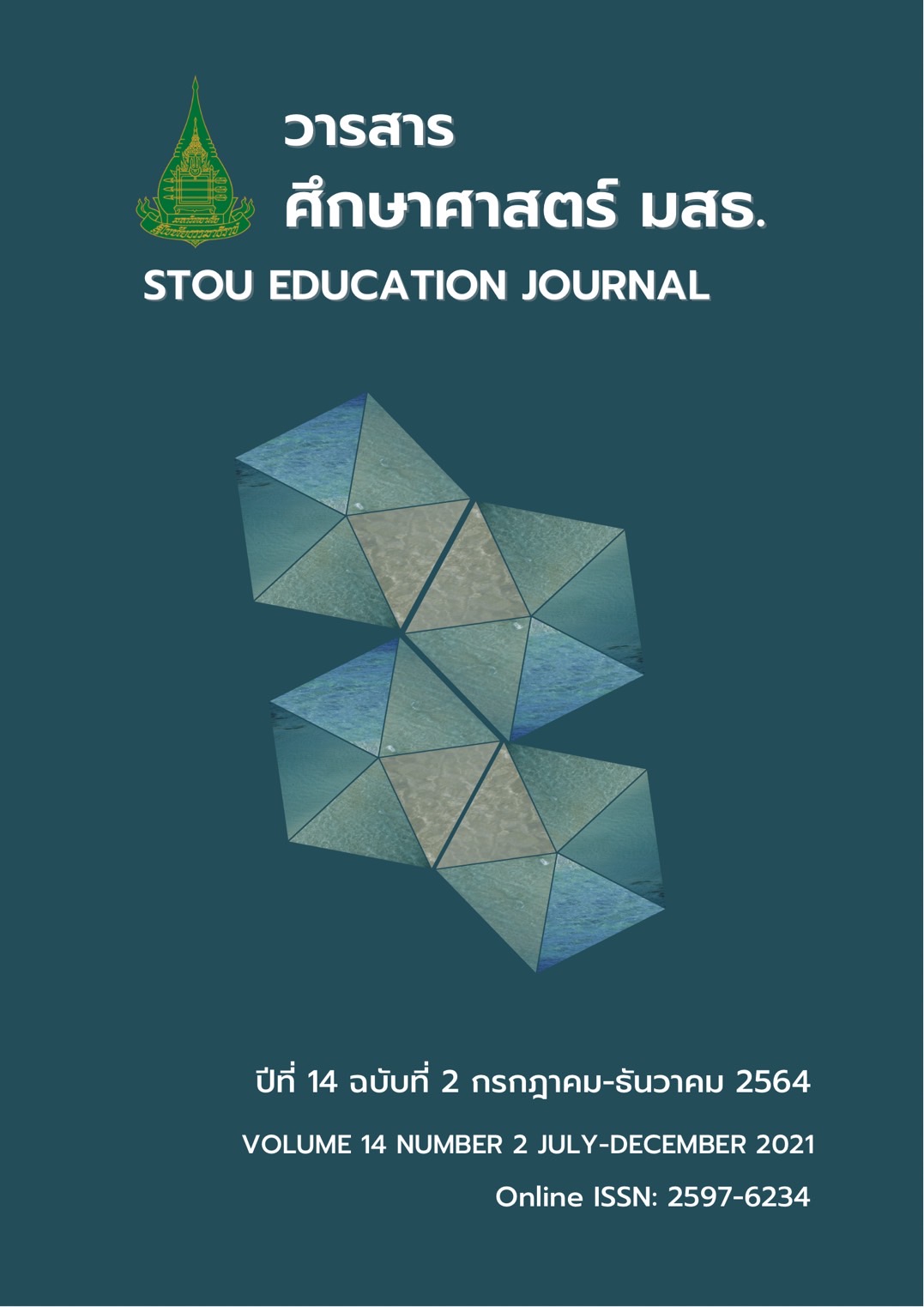ผลการสอนภาษาอังกฤษแบบบูรณาการทักษะที่มีต่อความสามารถในทักษะฟัง-พูด และเจตคติต่อการเรียนของนักศึกษาชั้นปีที่ 1 มหาวิทยาลัยราชภัฏอุบลราชธานี
Main Article Content
บทคัดย่อ
การวิจัยครั้งนี้มีจุดประสงค์เพื่อ 1) เปรียบเทียบความสามารถในทักษะฟัง-พูดของนักศึกษาชั้นที่ 1 มหาวิทยาลัยราชภัฏอุบลราชธานีก่อนและหลังการเรียนภาษาอังกฤษแบบบูรณาการทักษะ และ 2) เปรียบเทียบเจตคติต่อการเรียนภาษาอังกฤษของนักศึกษาดังกล่าวก่อนและหลังการเรียนภาษาอังกฤษแบบบูรณาการทักษะ กลุ่มตัวอย่างที่ใช้ในการวิจัย ได้แก่ นักศึกษาชั้นปีที่ 1 มหาวิทยาลัยราชภัฎอุบลราชธานีที่ลงทะเบียนเรียนในรายวิชาภาษาอังกฤษเพื่อการสื่อสาร ในภาคการเรียนที่ 1 ปีการศึกษา 2563 จำนวน 50 คน ได้มาด้วยการสุ่มแบบกลุ่ม เครื่องมือที่ใช้ในการวิจัย ได้แก่ แผนการจัดการเรียนรู้แบบบูรณาการทักษะ แบบทดสอบวัดความสามารถในการฟังภาษาอังกฤษ แบบทดสอบวัดความสามารถในการพูดภาษาอังกฤษ และแบบวัดเจตคติต่อการเรียนภาษาอังกฤษ สถิติที่ใช้ในการวิเคราะห์ข้อมูล ได้แก่ ค่าเฉลี่ย ส่วนเบี่ยงเบนมาตรฐาน และการทดสอบค่าที ผลการวิจัยปรากฏว่า 1) คะแนนเฉลี่ยความสามารถในทักษะฟัง-พูดของนักศึกษาหลังเรียนสูงกว่าก่อนเรียนอย่างมีนัยสำคัญทางสถิติที่ระดับ .05 และ 2) นักศึกษามีเจตคติต่อการเรียนภาษาอังกฤษหลังเรียนมากกว่าก่อนเรียนอย่างมีนัยสำคัญทางสถิติที่ระดับ .05
Article Details
เอกสารอ้างอิง
บุญเลิศ วงศ์พรม. (2559, เมษายน 9). ภาษาอังกฤษเด็กไทยไม่ก้าวหน้าปัญหาอยู่ที่ใคร. กรุงเทพธุรกิจ. สืบค้นจาก http://www.bangkokbiznews.com/blog/detail/637424
ปราณี หลำเบ็ญสะ. (2559). การหาคุณภาพของเครื่องมือวัดและประเมินผล. ยะลา: มหาวิทยาลัยราชภัฏยะลา.
ธนกร สุวรรณพฤฒิ. (2558). การพัฒนารูปแบบการสอนกลยุทธ์การเรียนภาษาต่างประเทศ เพื่อเสริมสร้างความสามารถในการฟัง-พูดภาษาอังกฤษสําหรับนักศึกษาระดับตรี. (วิทยานิพนธ์ปริญญาปรัชญาดุษฎีบัณฑิต ไม่ได้ตีพิมพ์). มหาวิทยาลัยศิลปากร, กรุงเทพฯ.
ฐิตาภา สินธุรัตน์. (2558). หน่วยที่ 5 การจัดการชั้นเรียนภาษาอังกฤษ. ใน ประมวลสาระชุดวิชาการจัดประสบการณ์การเรียนรู้ภาษาอังกฤษ หน่วยที่ 1-7 (น. 1-51). นนทบุรี: สาขาวิชาศึกษาศาสตร์ มหาวิทยาลัยสุโขทัยธรรมาธิราช.
มณี แก้วมณี. (2554). ผลของการสอนแบบตอบสนองด้วยท่าทางและเล่าเรื่องที่มีต่อความสามารถในการฟังและการพูดภาษาอังกฤษของนักเรียนชั้นประถมศึกษาปีที่ 3 โรงเรียนวัดหัวกระสังข์จังหวัดฉะเชิงเทรา.
(วิทยานิพนธ์ปริญญามหาบัณฑิต ไม่ได้ตีพิมพ์). มหาวิทยาลัยราชภัฏราชนครินทร์, ฉะเชิงเทรา.
สถาบันทดสอบทางการศึกษาแห่งชาติ. (2563). สรุปผลการทดสอบทางการศึกษาระดับชาติขั้นพื้นฐาน ระดับชั้นมัธยมศึกษาปีที่ 6 ปีการศึกษา 2562. สืบค้นจาก http://www.admissionpremium.com/uploads/contents/2020032743453.pdf
สำนักงานวิชาการและมาตรฐานการศึกษา. (2561). หลักสูตรแกนกลางการศึกษาขั้นพื้นฐาน พุทธศักราช 2551 และมาตรฐานการเรียนรู้และตัวชี้วัดฯ (ฉบับปรับปรุง พ.ศ. 2560). สืบค้นจาก http://academic.obec.go.th/images/document/1559878925_d_1.pdf
อารีรักษ์ มีแจ้ง. (2558). หน่วยที่ 6 การจัดการเรียนการสอนภาษาอังกฤษที่บูรณาการทักษะการฟังและการพูด. ใน ประมวลสาระชุดวิชาการจัดประสบการณ์การเรียนรู้ภาษาอังกฤษ หน่วยที่ 1-7 (น. 1-51). นนทบุรี: สาขาวิชาศึกษาศาสตร์ มหาวิทยาลัยสุโขทัยธรรมาธิราช.
Abu-Mwais, H & Smadi, O. M. (2017). The effect of an integration-based instructional strategy on developing EFL students' listening skills. Arab World English Journal, 8(1), 355-371.
Akram, A. & Malik, A. (2010). Integration of language learning skills in second language acquisition.
International Journal of Arts and Sciences, 3(14), 231-240.
Education First. (2019). EF English Proficiency Index. Retrieved from
https://www.ef.com/~/media/centralefcom/epi/downloads/full-reports/v9/ef-epi-2019-english.pdf
Floriasti, T.W. (2013). Improving speaking skills through the use of integrated listening and speaking material for student teachers academic year 2012/2013. (Unpublished Master's Thesis). Retrieved from http://litu.tu.ac.th/fllt2013/www.fllt2013.org/private_folder/proceeding/369.pdf
Harmer, J. (2010). How to teach English (2nd ed.). Essex, England: Pearson Education.
Hinkel. E. (2017). Teaching speaking in integrated‐skills. In J.I. Liontas & M. DolliCarpini (Eds.), The TESOL Encyclopedia of English Language Teaching, Retrieved from https://onlinelibrary.wiley.com/doi/full/10.1002/9781118784235.eelt0256
Hinkel. E. (2018). Integrating the four skills: Current and historical perspectives. Retrieved from
http://www.elihinkel.org/downloads/Integrating_the_four_skills.pdf
Komila, M. (2019). Perspective of integrating listening and speaking skills in teaching English as a foreign language. European Journal of Research and Reflection in Educational Sciences, 7(12), 98-101.
Kaplan, R. M. & Saccuzzo, D. P. (2018). Psychological testing: Principles, applications and issues (9th ed.). Boston, MA: Cengage Learning.
Mekheimer, M. & Aldosari, H. (2013). Evaluating an integrated EFL teaching methodology in Saudi universities: a longitudinal study. Journal of Language Teaching and Research, 4(6), 1264-1276.
Ngan, C. T. (2013). The application of communicative activities in English speaking classes of grade 11th students at Cao Lanh city high school. (Unpublished Master's Thesis). Dong Thap University, Vietnam.
Office of Educational Assessment. (2020). Understanding Item Analyses. Retrieved from https://www.washington.edu/assessment/scanning-scoring/scoring/reports/item-analysis/
Orellana, E. P. (2014). The Communicative Approach in English as a Foreign Language Teaching. Retrieved from https://www.monografias.com/trabajos18/the-communicative-approach/the-communicative-approach.shtml
Pardede, P. (2017). Integrated skills approach in EFL classrooms: a literature review. English Education Department Collegiate Forum, 2, 147-159.
Savignon, S.J. (2015). Communicative language teaching: Linguistic theory and classroom practice. Retrieved from http://videa.ca/wp-content/uploads/2015/08/Communicative-language-teaching2.pdf
Tavil, Z. M. (2010). Integrating listening and speaking skills to facilitate English language learners’ communicative competence. Procedia Social and Behavioral Sciences, 10(9), 765–770.


